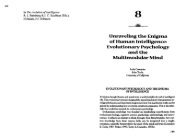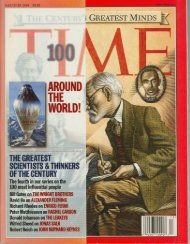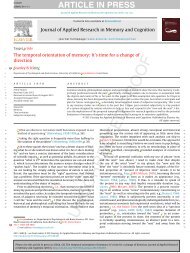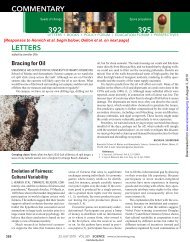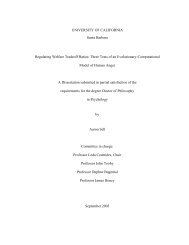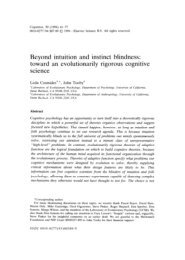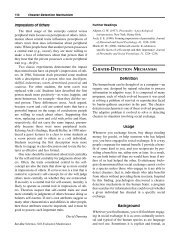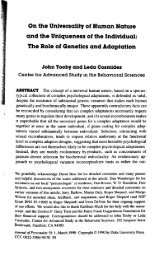evolution and the social mind - Center for Evolutionary Psychology
evolution and the social mind - Center for Evolutionary Psychology
evolution and the social mind - Center for Evolutionary Psychology
Create successful ePaper yourself
Turn your PDF publications into a flip-book with our unique Google optimized e-Paper software.
EVOLUTION AND THESOCIAL MIND<strong>Evolutionary</strong> <strong>Psychology</strong> <strong>and</strong>Social CognitionEdited byJoseph P. ForgasUniversity of New South WalesMartie G. HaseltonUniversity of Cali<strong>for</strong>nia at Los AngelesWilliam von HippelUniversity of New South Wales
4How <strong>the</strong> Mind WarpsA Social <strong>Evolutionary</strong> Perspective onCognitive Processing DisjunctionsDOUGLAS T. KENRICKANDREW W. DELTONTHERESA E. ROBERTSOND. VAUGHN BECKERSTEVEN L. NEUBERGOur Basic Model of How Fundamental Motives Influence CognitiveProcessesAn Unexpected Disjunction between Visual Attention, FrequencyEstimation, <strong>and</strong> MemoryAn Opposite Disjunction <strong>for</strong> Outgroup MalesSuppression <strong>and</strong> AmplificationDisjunctions’ FunctionsA General Model of <strong>the</strong> Biases Underlying DisjunctionsSome Empirical Implications of Considering Disjunctions in<strong>Evolutionary</strong>/Ecological TermsConclusionIf you walk down a crowded street at noon, which of <strong>the</strong> passing strangerscould you pick out of a lineup an hour later? From <strong>the</strong> st<strong>and</strong>point ofcommon sense, <strong>and</strong> of <strong>the</strong> traditional model of attention <strong>and</strong> memory,your ability to remember o<strong>the</strong>r people ought to depend on initial visual attention—you’llencode those faces you spent more time looking at, <strong>and</strong> laterremember those encoded faces that managed to make it into long-term memory.Our research program on basic <strong>social</strong> cognitive processes began with justthis set of apparently straight<strong>for</strong>ward assumptions—that memory <strong>for</strong> faceswill depend on encoding, which will in turn depend directly on initial visual49
50 EVOLUTION AND THE SOCIAL MINDattention (e.g., Craik & Tulving, 1975). We were surprised to find that we werewrong.Let’s begin with <strong>the</strong> classic three-step model of memory that has appearedin general psychology textbooks <strong>for</strong> decades. In simplified <strong>for</strong>m, this traditionalview involves a series of reasonably linear steps (Atkinson & Shiffrin, 1968).First, some subset of all <strong>the</strong> in<strong>for</strong>mation in a person’s current environment isregistered in sensory memory. For example, we visually attend to some stimuli<strong>and</strong> never even rest our fovea on o<strong>the</strong>rs: A person walking across a crowdedcollege campus would likely scan at <strong>the</strong> height of people’s faces, as opposed tolooking up at <strong>the</strong> sparrows <strong>and</strong> finches in <strong>the</strong> trees above her head (<strong>the</strong> oppositemight be true if she were a birdwatcher, but <strong>the</strong>n <strong>the</strong> finches, but not <strong>the</strong> faces,would get registered). At <strong>the</strong> second step, a smaller subset of <strong>the</strong> most “important”in<strong>for</strong>mation is selected <strong>for</strong> encoding <strong>and</strong> conscious processing in short-termmemory (Cowan, 1988). For example, most people in a large crowd may bescanned but never consciously registered; we fixate on a particular few, such as<strong>the</strong> man on stilts dressed in a clown costume, <strong>the</strong> fashion model, <strong>and</strong> <strong>the</strong> bluehairedgr<strong>and</strong>mo<strong>the</strong>r carrying a poodle. From this smaller subset of in<strong>for</strong>mationmaking <strong>the</strong> cut <strong>for</strong> short-term memory, a still smaller subset is presumed to getdeep enough consideration to make it into long-term memory (Ranganath,Cohen, & Brozinsky, 2005). If, <strong>for</strong> example, you have a conversation with <strong>the</strong>fashion model, who turns out to be your best friend’s cousin, you will remember<strong>the</strong> conversation later, while <strong>the</strong> fleeting image of <strong>the</strong> blue-haired gr<strong>and</strong>mo<strong>the</strong>r<strong>and</strong> her poodle are lost <strong>for</strong>ever. In this chapter, we explore a number of intriguing“disjunctions”—discrepancies between early <strong>and</strong> later in<strong>for</strong>mation processingthat violate <strong>the</strong> expected linear order in interesting ways. For some categories offaces, <strong>for</strong> example, observers better remember those <strong>the</strong>y looked away from;o<strong>the</strong>r categories of faces get preferential initial processing but are <strong>the</strong>n <strong>for</strong>gotten.One goal of this chapter is to begin developing a model of when <strong>and</strong> whyone might find <strong>the</strong>se sorts of processing disjunctions. Toward this end, we willconsider disjunctions as <strong>the</strong>y reflect more generally on <strong>evolution</strong>-inspired modelsof cognitive processing. The central assumption driving our research program isthat cognitive processing ultimately reflects a <strong>mind</strong> designed to extract <strong>and</strong> ponderin<strong>for</strong>mation prioritized by functional relevance. We begin with <strong>the</strong> broadassumption that attention, encoding, <strong>and</strong> memory, as well as <strong>the</strong> linkagesbetween <strong>the</strong>se basic processes, are designed to serve adaptive ends. If oneencounters unexpected nonlinearities, we believe it may be a mistake to adopt adefault presumption that <strong>the</strong>y simply reflect glitches in <strong>the</strong> system. Instead, it isworth considering whe<strong>the</strong>r such apparent glitches may reflect a generally functionalsystem (cf. Fletcher, Simpson, & Boyes, 2006; Forgas, chapter 7, thisvolume). Following a brief examination of several data sets in which we haveobserved interesting disjunctions, we suggest <strong>the</strong> outlines of a conceptual modelwith implications <strong>for</strong> underst<strong>and</strong>ing when <strong>and</strong> where disjunctions will be found.Finally, we reflect on some additional empirical implications of thinking aboutcognitive disjunctions more generally.
COGNITIVE DISJUNCTIONS51OUR BASIC MODEL OF HOW FUNDAMENTAL MOTIVESINFLUENCE COGNITIVE PROCESSESWith Mark Schaller <strong>and</strong> Jon Maner, we’ve been conducting a series of studiesdesigned to explore how simple cognitive processes (e.g., attention, encoding,recognition memory) are affected by what we’ve been calling fundamentalmotivational states (Kenrick, Neuberg, & Cialdini, 2005; Maner et al., 2005).Under <strong>the</strong> rubric of fundamental motivational states we include affiliation, selfprotection,status-seeking, mate-search, mate retention, <strong>and</strong> familial care. Weassume each of <strong>the</strong>se motivational states is species-typical <strong>for</strong> Homo sapiens—involving goals that our ancestors would have needed to meet to successfullysurvive <strong>and</strong> reproduce in human <strong>social</strong> groups (Kenrick, Li, & Butner, 2003).We presumed <strong>the</strong>re would be interesting interactions between bottom-upprocesses like visual scanning <strong>and</strong> top-down effects of fundamental motives. Afundamental motive is often activated by bottom-up processes—as when a <strong>social</strong>stimulus array indicates a mating opportunity, a threat to safety, or a chance toenhance one’s status. Once any powerful motivational state is activated, however,we presume it prompts increased attention to relevant features of <strong>the</strong> situation<strong>and</strong> suppresses attention to o<strong>the</strong>rs. Figure 4.1 depicts a partial model.As shown in Figure 4.1, we presumed that activation of a mating goal wouldincrease attention to attractive members of <strong>the</strong> opposite sex. We also presumedthis activation would inspire goal-relevant interpretations. In line with <strong>evolution</strong>basedassumptions of error management <strong>the</strong>ory (Haselton & Buss, 2000), <strong>for</strong>example, we expected males in a romantic frame of <strong>mind</strong> would be especiallylikely to see beautiful women as feeling sexual inclinations. We also expectedselective attention to attractive women would lead to overestimations of <strong>the</strong>frequency of those women in crowds of varying attractiveness. Finally, weexpected men would be more able to pick those attractive women out of a lineuplater. We expected both men <strong>and</strong> women in a self-protective frame of <strong>mind</strong> toattend instead to outgroup males, <strong>and</strong> to encode those men as relatively threatening.Given <strong>the</strong> phenomenon of outgroup homogeneity, we weren’t sure whe<strong>the</strong>rthis initial attention would translate into better memory <strong>for</strong> outgroup males;instead, we thought frightened participants might make more false alarms, falselyrecognizing outgroup men that <strong>the</strong>y had not seen.In some ways, our findings supported our predictions (Becker, Kenrick,Guerin, & Maner, 2005; Maner et al., 2003, 2005). But, as often happens, someunexpected findings were <strong>the</strong> most thought-provoking.AN UNEXPECTED DISJUNCTION BETWEEN VISUAL ATTENTION,FREQUENCY ESTIMATION, AND MEMORYOne series of studies examined visual attention indirectly using frequency estimation(Maner et al., 2003, Exps. 1–3). Observers were briefly presented with
52 EVOLUTION AND THE SOCIAL MINDFIGURE 4.1 Basic Model of Fundamental Goals’ Effects on In<strong>for</strong>mation Processing. Thismodel presumes activation of a given goal increases attention to goal-relevant stimuli, <strong>and</strong> <strong>the</strong>nbiases how we encode those stimuli, enhancing later memory <strong>for</strong> those stimuli. The model alsopresumes that activation of one goal inhibits processing of stimuli relevant to o<strong>the</strong>r goals, <strong>and</strong>that some goals (such as self-protection) have stronger inhibitory effects than o<strong>the</strong>rsarrays of attractive <strong>and</strong> average-looking male <strong>and</strong> female faces. Because observershad limited time to process <strong>the</strong> faces, we expected that faces capturing initialattention—such as attractive members of <strong>the</strong> opposite sex—should receivegreater processing <strong>and</strong> <strong>the</strong>re<strong>for</strong>e be preferentially encoded into long-term memory.Thus, when asked to estimate <strong>the</strong> frequencies of various categories of faces,observers of both sexes should overestimate <strong>the</strong> number of attractive members of<strong>the</strong> opposite sex.Results showed both sexes overestimating <strong>the</strong> number of attractive femalefaces, suggesting that attractive female faces captured everyone’s attention(Figure 4.2). Although <strong>the</strong> same effect was observed in both sexes, it did notseem to be due to <strong>the</strong> same mechanism: Such overestimations were more likely inmen not involved in committed relationships, but women who were involved inrelationships.
COGNITIVE DISJUNCTIONS53FIGURE 4.2 Frequency Estimation <strong>and</strong> Attractiveness. When people are briefly exposed toarrays of faces, both men <strong>and</strong> women overestimate attractive female faces but not attractivemales. Overestimation scores were created by taking estimations of attractive faces in brieflyshown arrays <strong>and</strong> subtracting estimations of attractive faces from a control condition wherearrays were shown <strong>for</strong> an extended period of time (so participants had time to process all of <strong>the</strong>faces). Thus, scores greater than zero indicate attractive faces were overestimated <strong>and</strong> scores lessthan zero indicate attractive faces were underestimated (data drawn from Maner et al., 2003,Exp. 1, Table 1)We were surprised to find female participants did not overestimate <strong>the</strong>number of attractive males, given that male attractiveness is a well-supportedcomponent in female mate preferences (e.g., Gangestad & Simpson, 2000).However, <strong>the</strong>se men were complete strangers to <strong>the</strong> women, <strong>and</strong> a strange mansimply may not reach <strong>the</strong> threshold as a mating opportunity <strong>for</strong> a woman, <strong>for</strong>reasons discussed below.The frequency estimation data suggested that people were preferentiallyattending to attractive women, but don’t really prove it, since frequency estimationinvolves a judgment that is cognitively “downstream” from attention per se.To examine visual attention directly, we turned to eye-tracking methods (Maneret al., 2003, Exp. 4). In <strong>the</strong>se studies, participants are presented with arrays ofdifferent faces, <strong>and</strong> we record how long <strong>the</strong>y dwell on different faces, <strong>and</strong> whichones <strong>the</strong>y return to. As expected from frequency estimation results, participantsof both sexes did preferentially visually attend to attractive females as comparedto average looking females. This was especially true <strong>for</strong> male participants with
54 EVOLUTION AND THE SOCIAL MINDFIGURE 4.3 Visual Attention <strong>and</strong> Attractiveness. Fixation scores greater than .50 indicatepreferential attention to attractive faces. Both sexes preferentially attended to attractive femalefaces <strong>and</strong> women preferentially attended to attractive male faces. Had a disjunction notoccurred <strong>the</strong> pattern in this graph should match <strong>the</strong> graph in Figure 4.2 (based on Figure 4from Maner et al., 2003, Exp. 4 © American Psychological Association)unrestricted mating orientations. Counter to <strong>the</strong> frequency estimation findings,however, women also preferentially looked at attractive over average lookingmales (see Figure 4.3; Figures 4.2–4.4 were constructed so without a disjunctioneach graph should have an identical pattern).These results were perplexing: Indirect measures suggested that attractivemales did not draw women’s attention, yet direct measures—tracking wherewomen’s eyes went—showed <strong>the</strong> opposite pattern. A final study helped resolvethis paradox. This study tested participants’ memory <strong>for</strong> attractive <strong>and</strong> averagemembers of both sexes. Results showed that both sexes, <strong>and</strong> women in particular,had accurate memory <strong>for</strong> attractive female faces but poor memory <strong>for</strong> attractivemale faces (Figure 4.4). So, female responses to attractive men provided our firstevidence of a disjunction between one stage of processing <strong>and</strong> ano<strong>the</strong>r: althoughattractive men captured women’s initial attention, this extra visual processing didnot translate into greater downstream processing—<strong>the</strong> attractive men werepromptly <strong>for</strong>gotten, <strong>and</strong> <strong>the</strong>ir frequency was not overestimated.
COGNITIVE DISJUNCTIONS55FIGURE 4.4 Memory <strong>and</strong> Attractiveness. Both sexes preferentially remembered attractivefemales. Women had particularly poor memory <strong>for</strong> attractive males. During testing, participantswere shown previously seen faces as well as novel foils <strong>and</strong> asked how confident <strong>the</strong>y werethat <strong>the</strong>y had seen <strong>the</strong> faces be<strong>for</strong>e. Relative memory confidence scores are based on ratings ofpreviously seen faces. These scores were computed by taking confidence scores <strong>for</strong> attractivefaces <strong>and</strong> subtracting confidence scores <strong>for</strong> average faces. Scores above zero indicate participantswere more confident in having seen attractive than average faces of that category,whereas scores below zero indicate <strong>the</strong> opposite. The effect shown in this graph probably helpsunderst<strong>and</strong> <strong>the</strong> disjunction depicted in Figures 4.2 <strong>and</strong> 4.3: Although women preferentiallyattend to attractive men, <strong>the</strong>y do not remember <strong>the</strong>m <strong>and</strong> thus do not later overestimate <strong>the</strong>m.These results are not an artifact of response bias: For novel foils, both sexes were more confidentthat <strong>the</strong>y had not seen novel male faces than novel female faces. In o<strong>the</strong>r words,previously seen <strong>and</strong> novel female faces were more accurately discriminated from each o<strong>the</strong>rthan previously seen <strong>and</strong> novel male faces (based on Figure 5 in Maner et al., 2003)Ano<strong>the</strong>r series of studies found a similar pattern among participants playinga version of <strong>the</strong> old Concentration game requiring <strong>the</strong>m to remember <strong>the</strong> locationof faces concealed behind tiles, <strong>and</strong> to match identical faces (by turning overonly two tiles on any given trial). Again, we found people of both sexes especiallygood at processing attractive women but not attractive men. Indeed, acrossthree studies, attractive men were matched somewhat less well than wereaverage-looking men (Becker et al., 2005).
56 EVOLUTION AND THE SOCIAL MINDFur<strong>the</strong>rmore, <strong>the</strong>re was again an intriguing disjunction between early <strong>and</strong>later processing. In one experiment, we first flashed up <strong>the</strong> full array (24 faces)<strong>for</strong> 6 s, be<strong>for</strong>e proceeding with <strong>the</strong> Concentration game as usual. In this variant,women were more likely to match h<strong>and</strong>some men than average looking men orwomen, but only on <strong>the</strong> initial trial (immediately after getting a view of <strong>the</strong>whole “crowd”). By <strong>the</strong> end of <strong>the</strong> game, however, this initial advantage <strong>for</strong>good-looking men had been lost. Again, h<strong>and</strong>some men (or at least h<strong>and</strong>somestrangers) had a very brief attentional advantage in women’s eyes, but thatadvantage did not persist into downstream processing (see Figures 4.5 <strong>and</strong> 4.6).FIGURE 4.5 Results from Concentration Game Study, Initial trial. These results are from<strong>the</strong> first trial only in a condition in which all participants first were briefly exposed to all faces.These results suggest both sexes’ attention was drawn by attractive females, <strong>and</strong> that h<strong>and</strong>somemen also drew initial attention (<strong>the</strong> latter trend was significant only <strong>for</strong> female participants)
COGNITIVE DISJUNCTIONS57FIGURE 4.6 Results from Concentration Game Study: Overall memory across all trials.These results suggest any initial processing advantage <strong>for</strong> <strong>the</strong> h<strong>and</strong>some men (as shown inFigure 4.5) was lost quickly after <strong>the</strong> initial trialsAN OPPOSITE DISJUNCTION FOR OUTGROUP MALESOur model of goal-directed cognitive processes led us to predict that activating aself-protection motive would cause people to (a) pay greater attention to o<strong>the</strong>rpeople who might be associated with heuristic danger cues, <strong>and</strong> (b) have biased
58 EVOLUTION AND THE SOCIAL MINDinterpretations of <strong>the</strong> possible threats those individuals might pose. In particular,we expected that perceived dangers would increase attention to outgroupmales.Consistent with our model, we did find that White students who are feelingthreatened (after watching a scary movie) are more likely to perceive anger in <strong>the</strong>faces of Black men (but not in <strong>the</strong> faces of Black women or White targets ofei<strong>the</strong>r sex) (Maner et al., 2005). These effects are not typical “priming effects”—in which people feeling a particular affective state perceive that same state ino<strong>the</strong>rs (e.g., Forgas & Bower, 1987). Ra<strong>the</strong>r than projecting fear onto o<strong>the</strong>rpeople’s faces, frightened participants projected anger, <strong>and</strong> did so only <strong>for</strong>members of a potentially threatening outgroup. Fear also led students withimplicitly negative attitudes toward Arabs to project anger onto <strong>the</strong> faces of Arabmen <strong>and</strong> women. We also found that White participants in a self-protectivestate overestimated <strong>the</strong> number of outgroup faces in <strong>the</strong> arrays (Becker et al.,2006).Ano<strong>the</strong>r set of eyetracker studies reveals that self-protective motivation,ra<strong>the</strong>r than causing White subjects to spend more time looking at outgroupmales, actually led <strong>the</strong>m to look away from men in general (Figure 4.7, toppanel). This visual aversion also occurs if <strong>the</strong> men in <strong>the</strong> photos appear to belooking directly at <strong>the</strong> participant, <strong>and</strong> is enhanced if <strong>the</strong> face is wearing an angryexpression.We would thus have expected to find that pictures of Black men, fromwhom visual attention has been diverted, would be especially difficult to pick outof a line-up later. But instead we have found that priming self-protection caused<strong>the</strong>se nonattended outgroup males to be later remembered as well as, <strong>and</strong> sometimesbetter than, nonthreatening faces of ingroup members (Becker et al., 2006;Figure 4.7, bottom panel). In addition, <strong>and</strong> contrary to findings on outgrouphomogeneity, we repeatedly find that Black men are remembered with especiallyhigh accuracy if <strong>the</strong>y are angry (Ackerman et al., 2006; see Figure 4.8). Neutralblack men, on <strong>the</strong> o<strong>the</strong>r h<strong>and</strong>, produce a high hit rate, but also a high false alarmrate. The punchline of <strong>the</strong>se latter studies is that outgroup males all look <strong>the</strong>same, unless <strong>the</strong>y’re angry, in which case <strong>the</strong>y are remembered with high accuracy.White participants do not, however, remember <strong>the</strong>se angry outgroup malesbecause <strong>the</strong>y look at <strong>the</strong>m <strong>for</strong> a longer time; instead threatening faces seem tomanifest a version of “flashbulb memory” <strong>and</strong> require less visual attention toachieve superior recognition (Brown & Kulik, 1971).SUPPRESSION AND AMPLIFICATIONThese two types of disjunction can be called amplification <strong>and</strong> suppression effects.Amplification disjunctions occur when limited processing at an early stageleads to preferential “downstream” processing (illustrated in <strong>the</strong> upper line ofFigure 4.9). The findings <strong>for</strong> Black <strong>and</strong> angry males illustrate an amplification
COGNITIVE DISJUNCTIONS59FIGURE 4.7 Attention to Black <strong>and</strong> White Male Faces (top); Memory <strong>for</strong> These Same Faces(bottom) (from Becker et al., 2006, Exp. 1)disjunction: Fearful spent less time looking at <strong>the</strong> faces of outgroup males yet hadbetter memory <strong>for</strong> <strong>the</strong>m. Conversely, suppression disjunctions occur when preferentialprocessing at an early stage does not translate into preferential processingat a later stage (illustrated in <strong>the</strong> lower line of Figure 4.9). An example of this iswomen’s reactions to h<strong>and</strong>some male faces—women look preferentially at <strong>the</strong>semen, but do not remember <strong>the</strong>m later.
60 EVOLUTION AND THE SOCIAL MINDFIGURE 4.8 Memory <strong>for</strong> Black <strong>and</strong> White Faces. Although White participants are notespecially accurate at recognizing Black males with neutral facial expressions, <strong>the</strong>y are quiteaccurate in recognizing rapidly presented faces of angry Black men (based on Ackerman et al.,in press). This finding provides a disjunction with o<strong>the</strong>r results showing that people look awayfrom potentially threatening faces (especially outgroup males with angry expressions)DISJUNCTIONS’ FUNCTIONSWhy should <strong>the</strong>se two types of disjunction occur? In retrospect, both <strong>the</strong> amplification<strong>and</strong> suppression effects we found make functional sense. Because staringat a stranger can be a threat gesture, it should have been unsurprising that peoplelook away from potentially dangerous o<strong>the</strong>rs—outgroup males, <strong>for</strong> example,particularly if <strong>the</strong>y are angry <strong>and</strong> staring back, <strong>and</strong> particularly if o<strong>the</strong>r cues, suchas your own feelings of fear, suggest <strong>the</strong> current situation may be dangerous. Afascinating implication of this research is that not looking does not mean notattending. Given that those individuals never<strong>the</strong>less pose a threat, it makes sensethat <strong>the</strong> <strong>mind</strong> continues to process <strong>the</strong>m even though <strong>the</strong> eyes have discreetlymoved away. Thus, <strong>the</strong> amplification effect reveals a sort of a “flashbulbmemory” in which a brief but important stimulus gets enhanced mentalrepresentation later.The suppression effect <strong>for</strong> h<strong>and</strong>some male strangers seems less intuitivelysensible at first, but does fit well with findings on women’s criteria <strong>for</strong> mate
COGNITIVE DISJUNCTIONS61FIGURE 4.9 Two Different Types of Disjunction (Note: thanks to Mark Schaller <strong>for</strong> suggestingthis graphic depiction of disjunctions)choice. Several <strong>evolution</strong>ary psychologists have provided evidence to suggest thatmale physical attractiveness is associated with so-called “good genes” (e.g., Gangestad,Thornhill, & Garver, 2002). Hence, it makes sense that h<strong>and</strong>some men’sfaces elicit initial attention from women. Consistently, we found more visualfixations <strong>for</strong> h<strong>and</strong>some men amongst women who are ovulating, who areunrestricted, or who are in a romantic frame of <strong>mind</strong>. However, even if a womanis interested in a short-term relationship, it is unlikely that that relationship willbe with a man who has not stayed around long enough to pass several levels ofinitial screening. Be<strong>for</strong>e committing to a relationship with a man, women generallyrequire additional in<strong>for</strong>mation, including reliable in<strong>for</strong>mation about <strong>the</strong>man’s <strong>social</strong> status or financial status (Buunk, Dijkstra, Fetchenhauer, & Kenrick,2002; Kenrick, Sundie, Nicastle, & Stone, 2001; Li, Bailey, Kenrick, &Linsenmeier, 2002). Clark <strong>and</strong> Hatfield (1989) found in two studies conductedacross two decades that not a single woman accepted an offer of a sexual liaisonwith a strange man, even though about half were willing to go on a date withhim. One presumes that some of <strong>the</strong>se women, undergraduates at Florida Stateduring <strong>the</strong> peak of <strong>the</strong> sexual r<strong>evolution</strong>, were unrestricted, <strong>and</strong> that some wereovulating. But a total stranger, regardless of his good looks, simply does not pass<strong>the</strong> initial threshold <strong>for</strong> a woman to consider as a sexual partner. On <strong>the</strong> o<strong>the</strong>rh<strong>and</strong>, Clark <strong>and</strong> Hatfield’s data also made it abundantly clear that, <strong>for</strong> most
62 EVOLUTION AND THE SOCIAL MINDmen, a total stranger is well above threshold to meet his selection criteria—withover 70% of men saying yes to an offer of sex from a woman <strong>the</strong>y had neverbe<strong>for</strong>e met.Although both types of disjunctions violate <strong>the</strong> traditional linear view ofin<strong>for</strong>mation processing, <strong>the</strong>y make sense in light of a model presuming in<strong>for</strong>mationprocessing functions to promote survival <strong>and</strong> reproductive goals. Ra<strong>the</strong>rthan leading us to scrap our general functional model of cognitive processing,<strong>the</strong>n, <strong>the</strong>se disjunctions have rein<strong>for</strong>ced our view that cognitive systems areinherently adaptive.A GENERAL MODEL OF THE BIASES UNDERLYINGDISJUNCTIONS<strong>Evolutionary</strong> approaches to cognitive psychology generally presume some degreeof modularity; which implies that different types of content receive differenttypes of processing (e.g., Kenrick, Sadalla, & Keefe, 1998; Tooby & Cosmides,1992). A functional analysis of cognition thus suggests that content is of centralimportance; <strong>the</strong> decision rules used <strong>for</strong> processing in<strong>for</strong>mation about a potentialmating opportunity, <strong>for</strong> example, are different from <strong>the</strong> decision rules used <strong>for</strong>processing in<strong>for</strong>mation about a potential threat.An <strong>evolution</strong>ary perspective implies that <strong>the</strong> particular cognitive biasesused by any species should reflect functional constraints imposed by typicalproblems <strong>the</strong>ir ancestors had to face. So, <strong>for</strong> example, diurnal birds (with goodvision <strong>for</strong> finding food in daylight) condition nausea to <strong>the</strong> visual features ofnovel foods <strong>the</strong>y encounter, but rats (nocturnal creatures with poor vision whofind food at night) condition nausea to <strong>the</strong> taste of novel foods more easilythan to visual features (Wilcoxon, Dragoin, & Kral, 1971). Fur<strong>the</strong>r, a givenbird species may use different rules <strong>for</strong> remembering locations of food stores,features of aversive foods encountered in <strong>the</strong> past, <strong>and</strong> <strong>the</strong> song of <strong>the</strong>irspecies. The features of aversive foods are conditioned to nausea in a singletrial, <strong>and</strong> are very difficult to unlearn; <strong>the</strong> locations of stored foods are repeatedly<strong>and</strong> easily learned <strong>and</strong> <strong>for</strong>gotten, <strong>the</strong> species’ song is learned during aparticular critical period by different rules depending on <strong>the</strong> <strong>social</strong> arrangementtypically confronted by members of a particular species (Sherry &Schacter, 1987).In addition to different cognitive rules <strong>for</strong> learning <strong>and</strong> remembering differentkinds of input, animals also have different sensory capacities <strong>and</strong> differentinnate templates <strong>for</strong> recognizing recurrent patterns of stimulation with functionalsignificance. So, <strong>for</strong> example, hawks, which hunt small <strong>and</strong> fast-movinganimals from high above <strong>the</strong> earth, have exquisite color vision, including twoseparate foveas, <strong>and</strong> several times <strong>the</strong> density of rods that humans have (Ehrlich,Dobkin, & Wheye, 1988). On <strong>the</strong> o<strong>the</strong>r side, rabbits, a favorite food of <strong>the</strong>seraptors, have “hawk detectors”—early level pattern detectors built into <strong>the</strong>ir
COGNITIVE DISJUNCTIONS63retina (to avoid <strong>the</strong> several milliseconds’ delay associated with central processing,enough time <strong>for</strong> a speedy hawk to arrive) (Levick, 1967).Just as o<strong>the</strong>r animals inherit cognitive templates, so too do humans. Forinstance, all species have mechanisms that allow <strong>the</strong>m to recognize members of<strong>the</strong>ir own species <strong>and</strong> even <strong>the</strong>ir specific mates or offspring, <strong>and</strong> we would expecthumans to have reliably developing templates <strong>for</strong> recognizing attractive <strong>and</strong>unattractive members within each sex. These templates, while adaptively influencedby <strong>the</strong> developmental environment, should also have a great deal of builtincontent (Lieberman, Tooby, & Cosmides, 2003). Similarly, humans may havea template <strong>for</strong> outgroup member, but this template needs to be “filled in” with agreat deal of in<strong>for</strong>mation from <strong>the</strong> environment—<strong>the</strong> look of an enemy varies byplace <strong>and</strong> time, <strong>and</strong> <strong>the</strong> template must be learned <strong>and</strong> contrasted with learnedfeatures of people with whom we are familiar (cf. Hirshfeld, 1996).An <strong>evolution</strong>ary approach to cognition implies strongly that adaptivedesign of nervous systems did not suddenly stop with Homo sapiens, but that ourspecies has a brain <strong>and</strong> sensory mechanisms adapted to <strong>the</strong> recurrent dem<strong>and</strong>s ofhuman life. Humans don’t need early warning hawk-detection systems, but wedo confront a series of special problems involved in living with o<strong>the</strong>r humans.For one thing, we need to be highly attentive to <strong>the</strong> grunts <strong>and</strong> groans emanatingfrom <strong>the</strong> mouths of o<strong>the</strong>r humans, <strong>and</strong> to be able to recognize <strong>and</strong> make finediscriminations regarding very complex patterns within those utterances. Itmakes a big difference whe<strong>the</strong>r someone just said “No worries, mate” as opposedto “Nick’s worried, Mark!” Indeed, ample evidence suggests that <strong>the</strong> humanbrain is specially designed to receive <strong>and</strong> transmit linguistic in<strong>for</strong>mation in a waythat even our most intelligent primate cousins are not (Pinker, 1994).Our model of fundamental motivational systems presumes <strong>the</strong>re is special<strong>and</strong> differential processing <strong>for</strong> in<strong>for</strong>mation relevant to different <strong>social</strong> goals.Table 4.1 indicates what we think some of those biases are.We also presume <strong>the</strong>re are <strong>evolution</strong>arily significant variations in how differentindividuals respond to different types of in<strong>for</strong>mation associated with <strong>the</strong>sefundamental problem sets. Some of those individual differences, like sex, areinnate; some, like mating strategy, depend on interactions between innate characteristics<strong>and</strong> developmental inputs, <strong>and</strong> some, like one’s current mating statusor <strong>the</strong> existence of offspring, are mainly determined by experiential inputs thattrigger species-typical biases.SOME EMPIRICAL IMPLICATIONS OF CONSIDERINGDISJUNCTIONS IN EVOLUTIONARY/ECOLOGICAL TERMSAlthough not considered in an <strong>evolution</strong>ary framework, traditional cognitivepsychologists have uncovered evidence of analogous disjunctions in such phenomenaas “inattentional blindness” (not consciously registering objects eventhough a person is looking at those objects) <strong>and</strong> “covert attention” (conscious
64 EVOLUTION AND THE SOCIAL MINDTable 4.1 Domains of Social Life Posing Recurrent Problems, with Examples ofDecision Constraints, <strong>and</strong> Cognitive Biases Associated with EachSocial problemdomainCoalition<strong>for</strong>mationStatusSelf-protectionMate choiceRelationshipmaintenanceParental careEvolved decision constraints (examples)Exchange relationships are ultimatelybeneficial to <strong>the</strong> extent exchange partners(a) share our genes, (b) are good bets <strong>for</strong>future reciprocation.Men tend to compete <strong>for</strong> status more thanwomen do.Outgroup members <strong>and</strong> unrelatedmembers of own group pose recurrentsources of competition, disease, <strong>and</strong>physical threat.Mating opportunities are low cost <strong>for</strong>men, potentially higher cost <strong>for</strong> women;male commitment is key <strong>for</strong> femalereproductive success.Costs associated with loss of mating <strong>and</strong>parenting investment, slightly different,though overlapping, <strong>for</strong> women <strong>and</strong> men.Human parents have high investment inbiological offspring, potential conflictswith interests of unrelated children.Resultant cognitive biases (examples)Coalitional goals should lead topreferential attention to smiling orscornful expressions, particularly ontargets not sharing our genes.Status goals should lead to preferentialattention to large dominant males orattractive well-dressed females. Malesshould be especially prone to suchbiases.Attention to signs of anger, particularlyon faces of males <strong>and</strong>/or outgroupmembers. Attention to signs of diseasein unrelated o<strong>the</strong>rs.Mating goals should increase attentionto physical attractiveness in women, tostatus in men, <strong>and</strong> to one’s own matingrelevant characteristics. Women shouldbe attentive to signs of commitment indesirable males.Preferential attention to potentialinterlopers, particularly those of ownsex with desirable matingcharacteristics, or signs of interest inone’s own mate.Preferential attention to behavior ofunrelated children who are age-matesof own offspring, or to behaviors ofadults likely to pose threats (e.g., lowstatus males).processing of objects without looking directly at those objects) (e.g., Carrasco &McElree, 2001; Mack, 2003). A consideration of <strong>the</strong> different domains of <strong>social</strong>life suggests o<strong>the</strong>r places to look <strong>for</strong> disjunctions between <strong>the</strong> different stages ofcognition. For example, perhaps activation of status concerns will lead to atendency to look away from high status males, but to remember <strong>the</strong>m better thanwhen o<strong>the</strong>r motives such as affiliation or family care are activated. In describinghis years in Tibet, <strong>for</strong> example, Heinrich Harrer (1996) noted that everyonelooked immediately at <strong>the</strong> ground if <strong>the</strong> Dalai Lama came into view. One doubtsthat <strong>the</strong>y <strong>for</strong>got <strong>the</strong> initial glimpse of <strong>the</strong> young god-king, however. Whenparental motivations are activated, on <strong>the</strong> o<strong>the</strong>r h<strong>and</strong>, people may look awayfrom, but still remember, low status males (who are o<strong>the</strong>rwise quickly dismissedfrom fur<strong>the</strong>r processing). One might also expect that men with <strong>the</strong>ir relational
COGNITIVE DISJUNCTIONS65partners might show such a pattern <strong>for</strong> beautiful women—looking away, butcovertly devoting attentional resources.One might expect amplification disjunctions <strong>for</strong> subtle cues linked to <strong>social</strong>exclusion, signs of a mate’s infidelity, potential threats to one’s own status, ordisease cues in strangers, all of which are likely c<strong>and</strong>idates <strong>for</strong> privileged processing(Eisenberger, Lieberman, & Williams, 2003; Faulkner, Schaller, Park, &Duncan, 2004; van Vugt & Kurzban, chapter 14, this volume). On <strong>the</strong> o<strong>the</strong>rside, one might expect suppression effects <strong>for</strong> in<strong>for</strong>mation suggesting one’s owninsensitivity to <strong>the</strong> needs of rejected or downtrodden o<strong>the</strong>rs, or to in<strong>for</strong>mationsuggesting one’s own potential infidelities (“I really don’t think <strong>the</strong> attractivenew lab assistant is flirting with me, dear, she’s just a naturally friendly person”).There are potentially interesting connections between <strong>the</strong>se simple cognitivedisjunctions <strong>and</strong> o<strong>the</strong>r cognitive phenomena. What kinds of <strong>social</strong> stimulusdo we have difficulty keeping out of conscious working memory? One suspectssome <strong>social</strong> stimuli are harder to suppress than thoughts about white bears, <strong>and</strong><strong>the</strong>se might map nicely onto <strong>the</strong> domains in Table 4.1, <strong>and</strong> include insults toone’s status, threats to one’s children, attractive offers of infidelities, o<strong>the</strong>rs flirtingwith one’s mate, etc. There are also undoubtedly interesting adaptive discontinuitiesin judgment processes (cf. Todd, chapter 9, this volume). Fur<strong>the</strong>r,some <strong>for</strong>ms of psychopathology may be understood as individual differences inattention to, encoding of, <strong>and</strong> memory <strong>for</strong>, <strong>evolution</strong>arily significant <strong>social</strong>situations (cf. Badcock & Allen, chapter 8, this volume).We have found <strong>the</strong>oretically meaningful individual differences linked to<strong>the</strong>se cognitive biases, with males <strong>and</strong> females showing different reactions toattractive members of <strong>the</strong> opposite sex, <strong>for</strong> example, <strong>and</strong> individuals concernedabout safety being more susceptible to processing biases involving potentialthreats. From an <strong>evolution</strong>ary perspective, o<strong>the</strong>r individual differences in cognitiveprocessing might be expected based on life-history phase of <strong>the</strong> judge (differentcues ought to be privileged or suppressed by people who are prepubescent,courting, young parents, or gr<strong>and</strong>parents, <strong>for</strong> example), or <strong>the</strong> judge’s kinshipstatus vis-à-vis <strong>the</strong> targets being processed (cf. Laham, Gonsalkorale, & vonHippel, 2005; Park & Schaller, 2005).Ano<strong>the</strong>r interesting set of questions involves <strong>the</strong> neuropsychology of disjunctions.Perhaps emerging neuropsychological methods could be used toexamine <strong>the</strong> possibility that certain <strong>social</strong> stimuli (such as recently encounteredh<strong>and</strong>some strangers) are inaccessible to conscious processing, but never<strong>the</strong>lessaccessible to processing at o<strong>the</strong>r levels. Might females show physiological signs ofrecognition of <strong>the</strong>se attractive men even as <strong>the</strong>y are reporting an inability to recall<strong>the</strong>m? If so, this would be a memory equivalent of <strong>the</strong> findings on “blindsight”—in which people with certain types of brain damage are unable to report seeing astimulus, but can point correctly when asked to guess where it is in <strong>the</strong> visualfield.
66 EVOLUTION AND THE SOCIAL MINDCONCLUSION<strong>Evolutionary</strong> models of cognitive processes are, in a sense, all about preferentialtreatment of certain classes of inputs, which often deviate from <strong>the</strong> st<strong>and</strong>ardassumptions applying to <strong>the</strong> processing of nonsense syllables or o<strong>the</strong>r “neutral”stimuli. <strong>Evolutionary</strong> models of cognition also typically assume that <strong>the</strong>se preferentialprocessing biases are associated with functionally relevant individual differences(Kenrick, 1994). As one example, consider <strong>the</strong> findings that, althoughmen are good at outdoor map-following tasks that would have fit with dispersedhunting, women are better at detecting <strong>and</strong> remembering <strong>the</strong> location of objectsin complex arrays, a skill critical to successful <strong>for</strong>aging (which is more often <strong>the</strong>province of women in preliterate societies) (e.g., Silverman & Eals, 1992). Likewise,detecting people who cheat on <strong>social</strong> contract rules is much easier th<strong>and</strong>etecting violators of logically identical rules that are not <strong>social</strong> contracts(Cosmides & Tooby, 1992).A particularly appealing feature of an <strong>evolution</strong>ary approach to cognition isthat, by emphasizing content, it can bring a whole new set of dimensions totraditional process-oriented approaches. The emphasis on domain specific qualificationsto domain-general processes, which suggests numerous separate <strong>and</strong>specialized cognitive modules adapted to specific fitness problems, has a numberof fruitful heuristic implications. The disjunctions we discussed here imply that<strong>the</strong> operation of domain-general cognitive processes <strong>the</strong>mselves, <strong>and</strong> specifically<strong>the</strong> links between <strong>the</strong>m, may be conditioned by more ancient motivational <strong>and</strong>emotional systems. Thus, while <strong>the</strong> traditional approach has yielded numerousimportant general descriptions of cognitive processing, adding an <strong>evolution</strong>aryperspective opens a whole new set of questions about how efficiently <strong>the</strong>sebasic processes work. Underst<strong>and</strong>ing <strong>the</strong>se processes should be important todeveloping a comprehensive <strong>and</strong> sensible model of how humans underst<strong>and</strong> <strong>and</strong>represent <strong>the</strong> <strong>social</strong> world.REFERENCESAckerman, J. M., Shapiro, J. R., Neuberg, S. L.,Kenrick, D. T., Schaller, M., Becker, D. V., etal. (2006). They all look <strong>the</strong> same to me(unless <strong>the</strong>y’re angry): From out-grouphomogeneity to out-group heterogeneity.Psychological Science, 17, 836–840.Atkinson, R. C. & Schiffrin, R. M. (1968).Human memory: A control system <strong>and</strong> itscontrol processes. In K. W. Spence & J. T.Spence (Eds.), The psychology of learning <strong>and</strong>motivation (Vol. 2, pp. 89–195). New York:Academic Press.Becker, D. V., Kenrick, D. T., Guerin, S., &Maner, J. K. (2005). Concentrating onbeauty: Sexual selection <strong>and</strong> sociospatialmemory. Personality <strong>and</strong> Social <strong>Psychology</strong> Bulletin,31, 1643–1652.Becker, D. V., Maner, J. K., Robertson, T.,Tybur, J., Shapiro, J., Ackerman, J., et al.(2006). A disjunction between attention <strong>and</strong>looking: Visual (in)attention to outgroupmales. Manuscript in preparation.Brown, R., & Kulik, J. (1971). Flashbulbmemories. Cognition, 5, 73–99.Buunk, B. P., Dijkstra, P., Fetchenhauer, D., &Kenrick, D. T. (2002). Age <strong>and</strong> gender dif-
COGNITIVE DISJUNCTIONS67ferences in mate selection criteria <strong>for</strong> variousinvolvement levels. Personal Relationships, 9,271–278.Carrasco, M., & McElree, B. (2001). Covertattention accelerates <strong>the</strong> rate of visual processing.Proceedings of <strong>the</strong> National Academy ofSciences, 98, 5363–5367.Clark, R. D. & Hatfield, E. (1989). Genderdifferences in receptivity to sexual offers.Journal of <strong>Psychology</strong> <strong>and</strong> Human Sexuality, 2,39–55.Cosmides, L., & Tooby, J. (1992). Cognitiveadaptations <strong>for</strong> <strong>social</strong> exchange. In J. Barkow,L. Cosmides, & J. Tooby (Eds.), The adapted<strong>mind</strong>: <strong>Evolutionary</strong> psychology <strong>and</strong> <strong>the</strong> generationof culture (pp. 277–306). New York:Ox<strong>for</strong>d University Press.Cowan, N. (1988). Evolving conceptions ofmemory storage, selective attention, <strong>and</strong> <strong>the</strong>irmutual constraints within <strong>the</strong> human in<strong>for</strong>mationprocessing system. PsychologicalBulletin, 104, 163–191.Craik, F. I., & Tulving, E. (1975). Depth ofprocessing <strong>and</strong> <strong>the</strong> retention of words inepisodic memory. Journal of Experimental<strong>Psychology</strong>: General, 104(3), 268–294.Ehrlich, P. R., Dobkin, D. S., & Wheye, D.(1988). Hawk-eyed. In The birder’s h<strong>and</strong>book:A field guide to <strong>the</strong> natural history ofNorth American birds (pp. 229–231). NewYork: Simon & Schuster.Eisenberger, N. I., Lieberman, M. D., & Williams,K. D. (2003, October 10). Does rejectionhurt? An fMRI study of <strong>social</strong> exclusion.Science, 302, 290–292.Faulkner, J., Schaller, M., Park, J. H., & Duncan,L. A. (2004). Evolved disease-avoidancemechanisms <strong>and</strong> contemporary xenophobicattitudes. Group Processes <strong>and</strong> IntergroupRelations, 7, 333–353.Fletcher, G. J. O., Simpson, J. A., & Boyes, A.D. (2006). Accuracy <strong>and</strong> bias in romanticrelationships: An <strong>evolution</strong>ary <strong>and</strong> <strong>social</strong> psychologicalanalysis. In M. Schaller, J. A.Simpson, & D. T. Kenrick (Eds.), Evolution<strong>and</strong> <strong>social</strong> psychology (pp. 189–209). NewYork: <strong>Psychology</strong> Press.Forgas, J. P., & Bower, G. H. (1987). Moodeffects on person perception judgments.Journal of Personality <strong>and</strong> Social <strong>Psychology</strong>,53, 53–60.Gangestad, S. W., & Simpson, J. A. (2000).The <strong>evolution</strong> of human mating: Trade-offs<strong>and</strong> strategic pluralism. Behavioral <strong>and</strong> BrainSciences, 23, 573–644.Gangestad, S. W., Thornhill, R., & Garver, C.E. (2002). Changes in women’s sexual interests<strong>and</strong> <strong>the</strong>ir partners’ mate retention tacticsacross <strong>the</strong> menstrual cycle: Evidence <strong>for</strong> shiftingconflicts of interest. Proceedings of <strong>the</strong>Royal Society of London, Series B, 269,975–982.Harrer, H. (1996). Seven years in Tibet. NewYork: Tarcher/Putnam.Haselton, M. G., & Buss, D. M. (2000). Errormanagement <strong>the</strong>ory: A new perspective onbiases in cross-sex <strong>mind</strong> reading. Journal ofPersonality <strong>and</strong> Social <strong>Psychology</strong>, 78, 81–91.Hirschfeld, L. A. (1996). Race in <strong>the</strong> making:Cognition, culture, <strong>and</strong> <strong>the</strong> child’s constructionof human kinds. Cambridge, MA: MITPress.Kenrick, D. T. (1994). <strong>Evolutionary</strong> <strong>social</strong>psychology: From sexual selection to <strong>social</strong>cognition. In M. P. Zanna (Ed.), Advancesin experimental <strong>social</strong> psychology (Vol. 26,pp. 76–122). San Diego, CA: AcademicPress.Kenrick, D. T., Li, N. P., & Butner, J. (2003).Dynamical <strong>evolution</strong>ary psychology: Individualdecision rules <strong>and</strong> emergent <strong>social</strong>norms. Psychological Review, 110, 3–28.Kenrick, D. T., Neuberg, S. L., & Cialdini, R.B. (2005). Social psychology: Unraveling <strong>the</strong>mystery. Boston: Allyn & Bacon.Kenrick, D. T., Sadalla, E. K., & Keefe, R. C.(1998). <strong>Evolutionary</strong> cognitive psychology:The missing heart of modern cognitive science.In C. Craw<strong>for</strong>d & D. L. Krebs (Eds.),H<strong>and</strong>book of <strong>evolution</strong>ary psychology (pp.485–514). Hillsdale, NJ: Lawrence ErlbaumAssociates, Inc.Kenrick, D. T., Sundie, J. M., Nicastle, L. D.,& Stone, G. O. (2001). Can one ever be toowealthy or too chaste? Searching <strong>for</strong> nonlinearitiesin mate judgment. Journal of Personality<strong>and</strong> Social <strong>Psychology</strong>, 80, 462–471.Laham, S. M., Gonsalkorale, K., & von Hippel,W. (2005). Darwinian gr<strong>and</strong>parenting: Preferentialinvestment in more certain kin. Personality<strong>and</strong> Social <strong>Psychology</strong> Bulletin, 31,63–72.Levick, W. R. (1967). Receptive fields <strong>and</strong> triggerfeatures of ganglion cells in visual streakof rabbit retina. Journal of Physiology, 188,285–307.
68 EVOLUTION AND THE SOCIAL MINDLi, N. P., Bailey, J. M., Kenrick, D. T., & Linsenmeier,J. A. (2002). The necessities <strong>and</strong>luxuries of mate preferences: Testing <strong>the</strong>trade-offs. Journal of Personality <strong>and</strong> Social<strong>Psychology</strong>, 82, 947–955.Lieberman, D., Tooby, J., & Cosmides, L.(2003). Does morality have a biological basis?An empirical test of <strong>the</strong> factors governingmoral sentiments relating to incest. Proceedingsof <strong>the</strong> Royal Society of London, Series B,270, 819–826.Mack, A. (2003). Inattentional blindness:Looking without seeing. Current Directions inPsychological Science, 5, 180–184.Maner, J. K., Kenrick, D. T., Becker, D. V.,Delton, A. W., Hofer, B., Wilbur, C. J., et al.(2003). Sexually selective cognition: Beautycaptures <strong>the</strong> <strong>mind</strong> of <strong>the</strong> beholder. Journalof Personality <strong>and</strong> Social <strong>Psychology</strong>, 85,1107–1120.Maner, J. K., Kenrick, D. T., Becker, D. V.,Robertson, T. E., Hofer, B., Neuberg, S. L.,et al. (2005). Functional projection: Howfundamental <strong>social</strong> motives can bias interpersonalperception. Journal of Personality<strong>and</strong> Social <strong>Psychology</strong>, 88, 63–78.Park, J. H., & Schaller, M. (2005). Does attitudesimilarity serve as a heuristic cue <strong>for</strong> kinship?Evidence of an implicit cognitiveassociation. Evolution <strong>and</strong> Human Behavior,26, 158–170.Pinker, S. (1994). The language instinct. NewYork: Morrow.Ranganath, C., Cohen, M. X., & Brozinsky, C.J. (2005). Working memory maintenancecontributes to long-term memory <strong>for</strong>mation:Neural <strong>and</strong> behavioral evidence. Journal ofCognitive Neuroscience, 17, 994–1010.Sherry, D. F., & Schacter, D. L. (1987). The<strong>evolution</strong> of multiple memory systems.Psychological Review, 94, 439–454.Silverman, I., & Eals, M. (1992). Sex differencesin spatial abilities: <strong>Evolutionary</strong> <strong>the</strong>ory<strong>and</strong> data. In J. H. Barkow, L. Cosmides, & J.Tooby (Eds.), The adapted <strong>mind</strong>: <strong>Evolutionary</strong>psychology <strong>and</strong> <strong>the</strong> generation of culture (pp.531–549). New York: Ox<strong>for</strong>d UniversityPress.Tooby, J., & Cosmides, L. (1992). Psychologicalfoundations of culture. In J. Barkow,L. Cosmides, & J. Tooby (Eds.), The adapted<strong>mind</strong>: <strong>Evolutionary</strong> psychology <strong>and</strong> <strong>the</strong> generationof culture (pp. 19–136). New York:Ox<strong>for</strong>d University Press.Wilcoxon, H. C., Dragoin, W. B., & Kral, P. A.(1971). Illness-induced aversions in rat <strong>and</strong>quail: Relative salience of visual <strong>and</strong> gustatorycues. Science, 171, 826–828.



